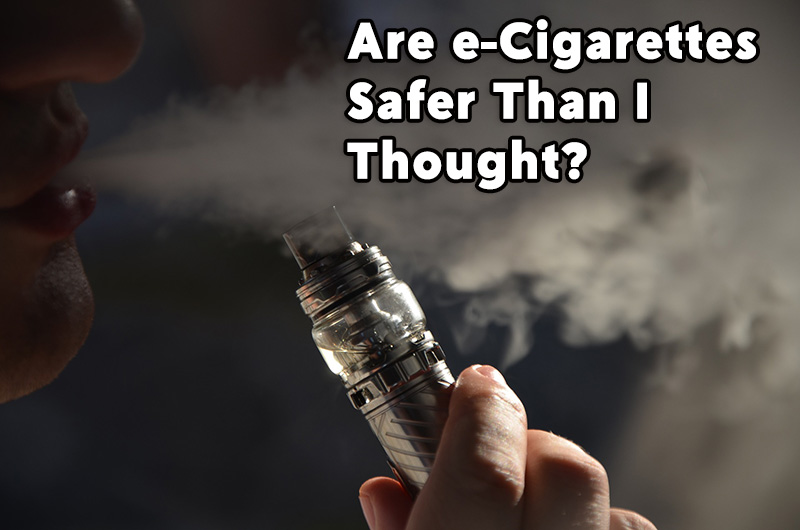Table of Contents [show]

Are e-Cigarettes Safer than Tobacco Products?
A couple of night ago I listened to a podcast featuring Jason Healy, CEO of Blu Cigs and often regarded around these offices as the “Steve Jobs of the eCig industry” *. Although the host of the show only managed to ask a handful of questions in the one-hour interview I gleaned some tasty bits of information from it. Some of them I found surprising. This opinion piece is based on one of his answers. – ed
The Blu Cigs Disposable, in Classic Tobacco and Menthol, are 24mg nicotine eCigs that deliver in excess of 400 puffs of pleasure. I’d vape them daily if I could, but at $10 a pop that would amount to $300-$310 a month, much more than I can afford.
Anyway, these disposables are great sellers in places like Walgreens Pharmacies because they serve as an introduction to the whole eCig experience and they are great for eCig users on the go that happen to not have access to their usual eCig.
The 24MG level disposable packs a heck of a throat hit, which is why I like them so much. But, until I heard Mr Healy’s remark about nicotine absorption I used to worry that I was taking in too much nicotine because I vaped the disposable constantly. The disposable would last me a single day, sometimes less.
During the interview Healy told the audience that if you vaped an entire disposable in one sitting that you would absorb less nicotine then you would with a single standard tobacco cigarette.
Think about that.
Less than one tobacco cigarette!
This is not some factoid picked out of thin air. Blu Cigs has science and their own testing behind it. It is true.
Let’s Talk About Both
Introduction to e-Cigarettes and Tobacco Products
Welcome to our blog post where we dive into the controversial topic of e-cigarettes versus tobacco products. With the rise in popularity of e-cigarettes, it’s important to understand their potential risks and benefits compared to traditional tobacco products. Are e-cigarettes truly a safer alternative? Let’s explore the facts and shed light on this heated debate.
Whether you’re a curious consumer or someone looking for ways to kick the habit, stay with us as we unravel the truth behind these smoke-filled choices!
The Dangers of Tobacco Products: Health Risks and Statistics
Tobacco products have long been known to pose serious health risks to those who use them. The statistics surrounding the dangers of tobacco are alarming and highlight the need for caution when considering their use.
First and foremost, tobacco products contain numerous harmful chemicals that can have a detrimental impact on our bodies. These include carcinogens such as formaldehyde and benzene, which increase the risk of developing various types of cancer. In addition, tobacco contains nicotine, an addictive substance that keeps users hooked and makes it difficult to quit smoking.
The effects of using tobacco products extend beyond just physical health concerns. Studies have shown that smokers are more likely to experience mental health issues such as anxiety and depression. Furthermore, secondhand smoke from cigarettes can also be extremely harmful to those around us, increasing their risk of respiratory problems and even lung cancer.
When we look at the numbers, they speak volumes about the dangers of tobacco. According to the World Health Organization (WHO), smoking is responsible for over 8 million deaths worldwide each year. Additionally, it is estimated that by 2030, this number could rise to more than 10 million if no action is taken.
These statistics serve as a stark reminder of why we must take measures to reduce tobacco use in our society. Whether it’s through education campaigns or implementing stricter regulations on advertising and sales, every effort counts in safeguarding public health.
Understanding the Ingredients in Both Products
When it comes to e-cigarettes and tobacco products, understanding the ingredients is crucial in determining their safety. Let’s take a closer look at what goes into these products.
Tobacco products, such as cigarettes, contain thousands of chemicals, many of which are known to be harmful. These include nicotine, tar, carbon monoxide, formaldehyde, and benzene. These substances have been linked to various health problems like lung cancer and heart disease.
On the other hand, e-cigarettes typically consist of three main components: a cartridge filled with e-liquid (which usually contains nicotine), a heating element or atomizer that heats up the liquid when activated by inhalation or button press, and a battery that powers the device. The e-liquid itself consists of propylene glycol or vegetable glycerin as solvents for delivering flavors and sometimes nicotine.
While both types of products contain nicotine – an addictive substance found in tobacco – e-cigarettes eliminate many other harmful chemicals present in traditional cigarettes. This reduction in toxic compounds makes them a potentially safer alternative for adult smokers who are looking to quit or reduce their tobacco consumption.
It’s important to note that while some studies suggest potential risks associated with certain flavorings used in e-liquids or other additives like diacetyl (a chemical linked to lung disease), regulations have been put in place by governing bodies to ensure product safety and limit exposure to such elements.
By understanding the ingredients present in both e-cigarettes and tobacco products, consumers can make informed decisions about which option aligns best with their individual needs and goals. It’s always advisable for individuals seeking alternatives from smoking traditional cigarettes to consult healthcare professionals for guidance on healthier options available on market since long-term effects still require further scientific research
Comparing the Health Effects of Using e-Cigarettes vs Tobacco Products
When it comes to comparing the health effects of using e-cigarettes versus tobacco products, there are several important factors to consider. First and foremost, it’s essential to understand that both e-cigarettes and traditional tobacco cigarettes contain nicotine, which is highly addictive to most people.
However, one significant difference between the two is that while traditional tobacco cigarettes produce smoke through combustion, e-cigarettes work by heating a liquid solution that typically contains nicotine. This means that e-cigarette users are not exposed to the harmful chemicals produced by burning tobacco.
Research suggests that vaping with e-cigarettes may be less harmful than smoking traditional cigarettes because they do not produce many of the toxic substances found in cigarette smoke such as tar and carbon monoxide. However, this does not mean that using e-cigarettes is completely safe or without risks.
There have been concerns about potential health risks associated with long-term use of e-cigarettes, including lung damage and respiratory issues. Additionally, some studies suggest that certain flavorings used in e-liquids could pose health hazards when heated and inhaled.
It’s also worth noting that while some individuals may use e-cigarettes as a tool for quitting smoking altogether, others may end up dual-using both traditional cigarettes and electronic devices.
Making an informed decision about whether to use e-cigarettes or stick with traditional tobacco products requires considering all available information on their respective potential health effects. It’s crucial for individuals who currently smoke or are considering trying either option to consult with healthcare professionals for personalized advice on harm reduction strategies and smoking cessation methods.
Potential Long-Term Effects of Using e-Cigarettes vs Tobacco Products
When it comes to the potential long-term effects of using e-cigarettes versus tobacco products, there is still much debate and ongoing research, and some dedicated believers in vaping. While traditional tobacco products have been extensively studied and proven to be detrimental to health, the same cannot be said for e-cigarettes.
One concern with e-cigarettes is that they contain nicotine, which can lead to addiction. Nicotine itself is known to have harmful effects on the body, including increased heart rate and blood pressure. However, some argue that since e-cigarettes do not produce tar or other toxic chemicals found in traditional cigarettes, they may still pose a lower risk overall.
Another consideration is that while traditional cigarettes are known to cause lung cancer and other respiratory diseases due to inhaling smoke, the long-term effects of inhaling vapor from e-cigarettes are not yet fully understood. Some studies suggest that certain chemicals used in vaping liquids may cause damage to lung tissue over time.
Additionally, there are concerns about the potential for e-cigarette use among young people leading them down a path towards smoking traditional cigarettes later in life. The flavors and marketing tactics employed by some e-cigarette companies have been criticized for targeting youth audiences.
In conclusion (not conclusive), more research needs to be done on both the short-term and long-term effects of using both e-cigarettes and tobacco products before any definitive conclusions can be reached. It’s important for individuals considering these options to weigh the risks against their individual circumstances and make informed decisions based on available information
Regulations and Restrictions on e-Cigarettes and Tobacco Products
Regulations and restrictions play a crucial role in ensuring the safety of consumers when it comes to e-cigarettes and tobacco products. As the popularity of these products has grown, so too have the regulations surrounding their sale, marketing, and use.
Many countries have implemented age restrictions to prevent minors from accessing these products. In some places, there are even stricter regulations that require ID checks upon purchase. These measures aim to protect young people from starting a habit that can have detrimental health effects.
Furthermore, advertising and marketing rules for e-cigarettes and tobacco products are becoming more stringent. This is in response to concerns about misleading claims or targeting vulnerable groups such as non-smokers or children with appealing flavors.
In terms of product safety, there are also regulations in place regarding ingredient disclosure and manufacturing standards. This helps ensure that consumers know exactly what they’re inhaling and reduces the risk of contamination or harmful additives.
Additionally, some jurisdictions have implemented smoking bans in certain public areas to protect both smokers and non-smokers from secondhand smoke exposure. However, it’s important to note that these restrictions may vary depending on local laws.
Regulations on e-cigarettes and tobacco products continue to evolve as new research emerges about their potential risks. By staying informed about these rules, individuals can make better decisions for their own health while governments work towards creating safer environments for everyone.
Making an Informed Decision: Weighing the Risks and Benefits
When it comes to choosing between e-cigarettes and tobacco products, it is crucial to weigh the risks and benefits associated with each option. Understanding the potential health effects of both choices is essential in making an informed decision.
On one hand, traditional tobacco products have long been known for their detrimental impact on our health. They contain numerous harmful chemicals that can lead to serious diseases such as lung cancer, heart disease, and respiratory issues. The statistics are alarming; cigarette smoking alone causes more than 480,000 deaths annually in the United States.
E-cigarettes, on the other hand, are often marketed as a safer alternative to traditional cigarettes. While they do not produce smoke like tobacco products do, they still deliver nicotine – a highly addictive substance that can have negative effects on cardiovascular health. Additionally, there is limited research available regarding the long-term impacts of e-cigarette use.
It’s important to consider regulations surrounding these products as well. E-cigarettes are subject to certain restrictions and guidelines imposed by regulatory bodies due to concerns about their safety and appeal among young people. Tobacco products also face strict regulations aimed at reducing harm caused by smoking.
In weighing these risks and benefits, it becomes clear that while e-cigarettes may be considered a potentially less harmful alternative compared to tobacco products for adult smokers seeking cessation options or harm reduction strategies; however caution should be exercised due to lack of comprehensive scientific evidence concerning their long-term effects.
Ultimately though,the decision of whether or not to use e-cigarettes or tobacco products lies with each individual consumer after carefully evaluating all available information regarding potential risks and benefits
Electronic Cigarettes ARE Safer Than Tobacco
When it comes to the debate between electronic cigarettes (e-cigarettes) and tobacco products, one thing is clear: e-cigarettes are generally considered safer than their traditional counterparts. While this statement might seem controversial to some, there is a growing body of evidence that supports this claim.
In terms of health risks, e-cigarettes have been found to contain fewer harmful chemicals and toxins compared to tobacco products. Traditional cigarettes produce smoke when burned, which releases thousands of toxic compounds into the air and can be inhaled by both smokers and those around them.
In contrast, e-cigarettes do not involve combustion but rather heat up a liquid solution containing nicotine. This means that users are exposed to significantly lower levels of harmful substances.
Another advantage of e-cigarettes is the ability for users to control their nicotine intake. Unlike traditional cigarettes that deliver a fixed amount of nicotine with each puff, e-cigarette users can choose from various nicotine concentrations or even opt for nicotine-free options altogether.
This allows individuals who want to quit smoking or reduce their nicotine dependence to gradually wean themselves off without experiencing severe withdrawal symptoms.
Furthermore, while long-term studies on the effects of using e-cigarettes are still ongoing, current research suggests that they pose fewer risks compared to tobacco products. The detrimental health effects associated with smoking traditional cigarettes are well-documented and include an increased risk of lung cancer, heart disease, stroke, respiratory problems, and more.
In contrast, although not entirely risk-free due to the presence of certain potentially harmful ingredients like flavorings or solvents in some products-—which need further investigation—-e-cigarettes have been found by many experts as being less harmful overall.
It’s important also consider regulations surrounding these two types of products; governments worldwide have implemented strict regulations on tobacco advertising and packaging design in order o discourage its use among consumers-especially young people-, whereas similar restrictions apply increasingly fastly on vaping devices too – especially regarding marketing directed towards minors-.
These measures aim to prevent the initiation and encourage cessation of tobacco smoking, which is responsible for
Conclusion
In weighing the risks and benefits of using e-cigarettes versus tobacco products, it is clear that electronic cigarettes are a safer alternative. While both options contain nicotine, which is addictive and has its own set of health concerns, e-cigarettes eliminate many of the harmful chemicals found in traditional tobacco products.
The dangers of tobacco products cannot be overlooked. From increased risk of cancer to cardiovascular disease, smoking cigarettes poses significant health risks. The statistics speak for themselves – millions of lives have been lost or impacted by the use of tobacco.
On the other hand, e-cigarettes offer a potentially less harmful option for those looking to quit smoking or reduce their nicotine intake. With fewer toxins and carcinogens present in e-cigarette vapor compared to cigarette smoke, users may experience fewer negative health effects.
It is important to note that long-term effects are still being studied. However, initial research suggests that e-cigarettes may be an effective tool in harm reduction strategies when used by adult smokers as a means to quit or cut back on traditional cigarette use.
Regulations and restrictions surrounding both e-cigarettes and tobacco products vary from country to country. It is crucial for consumers to stay informed about local regulations and make responsible choices regarding their own health.
Making an informed decision about whether to use e-cigarettes or tobacco products requires careful consideration of personal circumstances and weighing the potential risks against potential benefits with input from healthcare professionals where necessary.
While no product is completely without risk, it seems evident that choosing electronic cigarettes over traditional tobacco can lead towards a safer path. As more research continues to emerge on this topic, it remains imperative for individuals considering these options to remain updated on current findings in order make well-informed decisions regarding their own health and well-being
More in Spinfuel
Weak Hits with a Disposable Vape? Here’s How to Fix It
The Weird Cannabis Relationship With the State of Illinois
Vaping – Hobby and Lifestyle? Here’s How to Tell
Vaping Facts – Some Interesting Must-Know Facts
Considering the Healthy Move to Vaping? Here Are Some Tips To Getting Started (2019)




